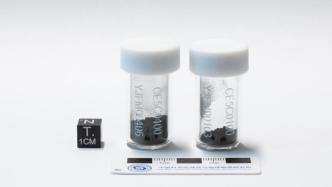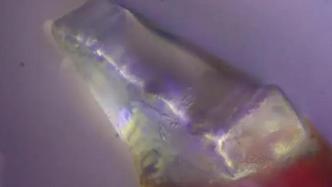
The reporter learned from the Institute of Physics of the Chinese Academy of Sciences today (23rd) that Chen Xiaolong, a researcher at the Institute of Physics of the Chinese Academy of Sciences/Beijing National Research Center for Condensed Matter Physics, associate researcher Jin Shifeng, and doctoral candidate Hao Muchan, etc., jointly with Associate Professor Guo Zhongnan of the University of Science and Technology Beijing and Tianjin University Engineer Yin Bohao, researcher Ma Yunqi of the Qinghai Salt Lake Institute of the Chinese Academy of Sciences, and engineer Teresa Deng of Zhengzhou University discovered an unknown mineral crystal on the moon that is rich in water molecules and ammonium - ULM- in the lunar samples brought back by Chang'e 5. 1. This marks the first time scientists have discovered molecular water in lunar soil, revealing the true existence of water molecules and ammonium on the moon. The research results were recently published online in the academic journal Nature Astronomy.
The existence of water on the moon is crucial to the study of lunar evolution and resource development. Studies of Apollo samples collected between 1969 and 1972 showed that no hydrous minerals were found in the lunar soil. Since then, it has become a basic assumption of lunar science that the moon does not contain water, which has had an important impact on understanding issues such as the evolution of lunar volcanoes and the origin of the moon and the earth. In 1994, researchers used the Clementine probe to observe the lunar poles and proposed that water ice may exist in the lunar soil in the permanently shadowed areas of the polar regions. In 2009, the Lunar Mineral Mapping Spectrometer on board Chandrayaan-1 discovered the presence of hydroxyl and/or water molecule signals caused by solar wind on the lunar surface. In the same year, the Lunar Observation and Sensing Satellite impacted the Moon's permanently shadowed region at 2.5 km/s, and remote sensing measurements of the impact dust revealed a signal of water. In recent years, remote sensing data has shown evidence of the presence of water molecules in illuminated areas of the moon. For the Apollo lunar samples collected that year, scientists used highly sensitive characterization techniques and found one millionth of "water" (H+, OH- or H2O) in some glasses and minerals, but no water molecules existed. conclusive evidence.

Unknown mineral crystals rich in water molecules and ammonium - ULM-1 and composition
The lunar soil samples collected by my country's Chang'e 5 belong to the youngest basalt and are the highest latitude lunar samples so far, providing new opportunities for the study of lunar water. This study conducted by Chinese researchers based on single crystal diffraction and chemical analysis found that these lunar water and ammonium appear in the form of a hydrated mineral with the composition (NH4, K, Cs, Rb) MgCl3·6H2O. The mineral's molecular formula contains up to six crystal waters, and the mass ratio of water molecules in the sample is as high as 41%. Characteristic vibration peaks originating from water molecules and ammonium can be clearly observed in both infrared and Raman spectra. The charge density of the crystal makes it possible to clearly see the hydrogen in the water molecules. The crystal structure and composition of ULM-1 are similar to a rare volcanic crater mineral discovered on Earth in recent years. On Earth, the mineral is formed by the interaction of hot basalt with volcanic gases rich in water and ammonia. This provides new clues about the origin of water and ammonia on the moon.
To ensure the accuracy of this finding, the study conducted rigorous chemical and chlorine isotope analyses. Nanosecondary ion mass spectrometry data shows that the Cl isotope composition of this mineral is significantly different from that of Earth minerals and is consistent with minerals on the moon. The researchers' analysis of the mineral's chemical composition and formation conditions further ruled out terrestrial contamination or rocket exhaust as the source of the hydrate. The presence of this hexahydrate mineral gives important constraints on the composition of lunar volcanic gases. Thermodynamic analysis shows that the lower limit of water content in the lunar volcanic gases at that time was equivalent to that of the Lengei volcano, which is currently the driest on Earth. This reveals the complex history of lunar volcanic degassing, which is of great significance for exploring the evolution of the moon.
The discovery of this hydrated mineral reveals a possible form of water molecules on the moon - hydrated salts. Unlike volatile water ice, this hydrate is very stable in the high-dimensional region of the moon (Chang'e 5 sampling site). This means that stable hydrated salts may exist even in the vast sunlit areas of the moon. This provides new possibilities for the development and utilization of lunar resources in the future.
